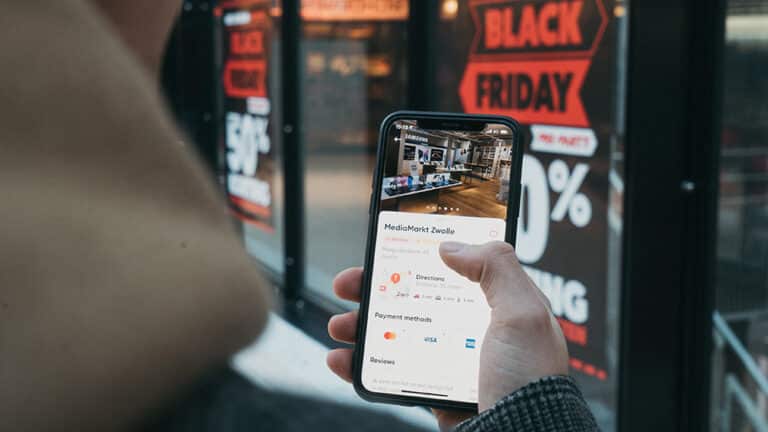The pandemic has changed our buying behavior globally and e-commerce has increased sharply as people around the world have stayed at home. According to ‘The future of shopping has come early report ’of Facebook IQ are two categories in the retail trade distinctive, which are about 1) Essential items and 2) Non-essential items. In the beginning of the pandemic, consumers bulged in anxiety, which led to a sharp increase for a short period and made the shelves empty in many grocery stores. In the United States, the food and beverage category increased by as much as 11.3% throughout the year.
The behavioral changes do not end there. It is necessary to understand consumers’ new behavior and expectations, to be able to get them matched early in your business model, user experience and marketing strategy – before the competitors are catching up. Below we will go through consumers’ buying behavior during the pandemic.
CHAPTER 1
Shopping Redefined: A re-examination of priorities is leading to complex purchasing decisions
Previously, consumers’ purchasing decisions were based on what range that was available in stores. This has changed in recent years in the wake of the expansion of e-commerce, in connection to paid marketing in digital channels. In 2020, consumption of e-commerce via mobile devices increased by 19% globally, accounting for 65% of the e-commerce total revenue worldwide. E-commerce has developed and opened up more alternatives for the consumer. The price is considered by the consumer to be a decisive factor online and in store and 61% say that they are actively looking for discounts or offers. As well known, many have been affected financially during the pandemic and therefore it is predicted that the price will continue to be a decisive factor in purchasing decisions.
“One of the things that consumers have started to recognise during COVID-19 is that their preference of where they shop means more to them than it did in the past. And it comes from a variety of reasons, not only safety and security, but also on their payment options, the inconveniences or conveniences they experience during their path to purchase and their purchase transaction. These are all things that are going to persuade a customer to be loyal – or not.” – Nicole Leinback Reyhle, ” Founder of Retail Minded
What do consumers themselves say then?
- 71% say that it is very important that they can shop safely in a physical store.
- 68% expect retailers to always have products they are interested in in stock.
- 75% say that the price determines where they are shopping.
- 68% say that reliability is a decisive factor in where they are shopping.
- 65% believe that accessibility and convenience are important.
- 63% think that good customer service is a decisive factor.
When we have those insights, what do we as marketers need to keep in mind in 2021?
- Adapt your platforms to your target audience’s buying behavior.
Regardless of whether the consumer decides to shop in a store or online, both shopping experiences need to feel safe, reliable and simple.
- The right message to the right target group.
Whether the consumer buys is individual and it is important to relate to the consumer depending on where in the purchase price the individual in question is. In our well-developed advertising tools, we can choose to optimize our ads where the consumer is most receptive.
- Values in focus.
Increased awareness among consumers entails higher demands. Regardless of whether the consumer chooses to shop in store or online, your brand’s values will be an important factor and something to include in your communication for increased trust among your potential customers. What position do you take in the market and how do you differentiate yourself from the competition?
CHAPTER 2
Navigating shopping risks: Consumers are facing new friction points in store and online
Previous research has shown that obstacles or a delay in a customer journey can be the reason why the consumer does not complete a purchase. But it has also shown that poor customer service or long queues have been another contributing factor. There has been a shift among consumers during the current pandemic from the time and economy being in focus to the fact that physical and mental risks affect the purchase price.
In consumer buying behavior, six risks have been identified from different aspects.
Functional: Will this product or experience work as I expected?
Physical: Is this product harmful to me?
Social: What will others’ experience of this product be?
Psychological: Will this product or experience cause emotional reactions?
Financial: Will I be able to afford to buy this product or service?
Time: How much time will I need to spend to buy this product?
“I think a lot of people do expect businesses to make them feel safe. That’s part of the customer experience. A good retailer will go out of their way to communicate to the customer everything that they’re doing to protect customers and their staff” – Clare Bailey, FOUNDER of The Retail Champion.
What risks do consumers say that they experienced themselves, when they shopped in a store during the pandemic?
- Time risk.
38% felt that they spent a long time in line and that it was difficult to find
- Functional risk.
37% felt that their products were not in stock or that they wanted to try the product before buying.
- Financial risk.
35% experienced high prices and few discounted periods.
- Physical risks.
25% did not feel safe in crowds.
- Social risk.
17% waited because they wanted to make a discreet purchase.
- Psychological risk.
9% felt stressed or irritated during their trade.
Several months after the pandemic broke out, 71% of consumers say that safety is a high priority for shopping in-store over online. It will probably continue to be a contributing factor influencing consumer purchasing decisions.
When we have those insights, what do we as marketers need to keep in mind in 2021?
- Developed services to reduce risk in physical stores.
The fact that the consumer does not have to walk around in the grocery store to buy groceries, and can pick up pre-packaged goods and have their goods delivered to their home has made them feel safer than when they shop directly in the physical store. If your company offers these services or for the most part has smart user experiences for safer online shopping, communicate it and run ahead of the competition!
- Optimize your digital platforms.
Consumers are increasingly turning to e-commerce and mobile shopping, so make sure your digital platforms are optimized and adapted for mobile devices. And ask yourself the question – what hygiene factors would have made you prefer to shop in an online store instead of a physical store?
- Flexible payment methods, fast deliveries and easy returns.
Trust needs to be overcome with new customers and through smoother online payment functions, fast deliveries and easy returns, you create a good customer experience that will probably make the customer want to return to shop.
CHAPTER 3
Reversing roles: “In store” is becoming transactional as online is becoming experiential
The pandemic has accelerated the digitalisation of society and caused e-commerce to grow explosively in 2020, largely due to fewer people choosing to shop in physical stores. But this is probably not a temporary shift but will remain the new normal – 32% say they will spend less time in physical stores even when the pandemic is over. It is the next generation of e-commerce. Consumers are looking for more convenient shopping and expect it to be easy to find the products they need based on their lifestyle.
“People are going out shopping with a purpose. They’ve probably done a lot of research, they know exactly what they want, they go, they do it, they leave. They’re spending more per visit and their visits are very much focused. That suggests there’s an awful lot of research that goes on online in advance of that shop visit so that they know exactly what they’re going for and they get it done.” – Clare Bailey, ” Founder of The Retail Champion.
What do consumers say about the development of spontaneous purchases vs. planned purchases globally?
- Food / Beverage: 68% are planning what kind of food and drinks they buy, while 32% make spontaneous purchases.
- Household items: 68% are planning what kind of household items they buy, while 32% make spontaneous purchases.
- Furniture: 66% are planning what furniture they buy, while 34% make spontaneous purchases.
- Electronics: 67% are planning what electronics they buy, while 33% make spontaneous purchases.
- Beauty: 64% are planning what kind of beauty items they buy, while 36% make spontaneous purchases.
- Personal items: 65% are planning what kind of items they buy, while 35% make spontaneous purchases.
- Clothes: 58% are planning what clothes they want to buy, while 42% make spontaneous purchases.
And in what way do consumers say they want to discover brands and products in the future?
- 38% say that they want to be able to categorize products according to current trends.
- 37% say that they want to be able to categorize products according to different lifestyles.
- 36% say that they want to be able to get short response forms which then tailor products to the customer’s unique needs.
- 35% say that they want to be able to photograph a product and be able to get search results on the product or similar products.
- 34% say that they want to be able to get dynamic lists based on previous purchases and needs.
- 33% say that they want to be able to get suggestions for products that are trending among your friends or people in your network
- 29% say that they want to be able to get suggestions for products that help them achieve specific goals. (For example: Decorate a children’s room, or running equipment for a marathon)
- 29% say they want their smart home features (such as Alexa or Google Home) to tell you about products that might be useful to you.
- 24% say that they want to be able to discover products via live broadcasts by influencers who use and review products.
- 23% say that they want to experience more brands arranging live broadcasts with representatives from the company who recommend the right products for the person.
When we have those insights, what do we as marketers need to keep in mind in 2021?
- Streamline your physical store.
Consumers are getting used to time-efficient shopping and see that physical stores should simplify for purchases through easy navigation in the stores as well as a better selection of fast cash registers. Are you at the forefront of these factors that affect the customer’s store experience? Then communicate your physical USPs!
- Try new ways to reach your target group.
Live shopping was a rising trend during the pandemic and is an effective way to engage and reach your customers when you do not have the opportunity to meet your customers physically.
- Try discovery commerce.
Discovery commerce is a system in Facebook that makes it possible to collect data about your target group’s buying interests. To then see what they interact with and make it easier for your target group to explore your range and find the right products, as you can match products that the target group may be interested in.
- Personal customer service.
Consumers want to feel safe when shopping online and through an active customer service via social media, where your company can provide quick answers to questions and advice, you have a great opportunity to build a unique trust. Which usually happens naturally in physical stores.
CHAPTER 4
Across the street and around the world: Shopping baskets are going “glocal”
Consumption and buying behavior have got a new meaning among consumers during the pandemic, and have created a stronger community between local and global businesses. The pandemic has contributed to consumers shopping more locally and wanting to support local and small-scale businesses that have had a tough time under the prevailing circumstances.
“What’s really interesting is that customers’ footfall has shifted away from city centres back to local communities, which actually is consistent with what we see in terms of a larger number of people continuing to work from home. A lot of people who obviously were working from home in the immediate period, or were furloughed, were shopping much more locally, and they were engaging much more with the local community and the smaller shops” – Clare Bailey, Founder of The Retail Champion.
So what do consumers say they have done to support their local businesses?
- 33% – made a purchase from a local / small business.
- 32% – recommended a local / small business to a family member or friend.
- 30% – chose to follow or like-mark a local / small business’ company page in social media.
- 23% – wrote a positive comment or review on a local / small business’ company page on social media.
- 20% – Recommended a local / small business to a group business
- 20% – shared or reposted an offer or content from a small / local business on social media.
So with those insights about local engagement in our knowledge, what do we as marketers need to keep in mind in 2021?
- Support local businesses.
We don’t know how long the pandemic will last and the majority of the population spends more time at home and we do not go out to physical stores as before, which makes it difficult for our local small businesses to survive. But we need to try to support them as much as possible by getting involved in some way and social media is an important factor in spreading the word. For example, can your company take a stronger position in the market by finding new collaborations with small business owners who have good synergies with your business?
- Digital presence as a small business owner.
Regardless of whether you have a large or small business, the pandemic has caused the development to take off and if you as a small business owner are to survive, you need to be active on social media. There are enormous opportunities there that are more than worth taking advantage of! Review your media budget and its actual ROI. If, for example, you had a routine of advertising in the local newspaper, you might instead consider placing that money on geographical advertising instead or why not set up your own online store via Facebook Shops and spend the money on a quality photo production of nice product images.
CHAPTER 5
The new loyalty equation: How empathy, transparency and value spell loyalty.
Changes in consumer buying behavior have occurred during the pandemic. Over 60% say they have changed their behavior by trying out new brands. It has shaken and reduced consumer loyalty to stores before the pandemic. Purchases have become more complex and challenging in that price and offer are what drive customers as loyalty and personal relationships cannot be built in the same way.
“Customers have higher expectations from retailers to deliver on strong customer care in order for them to stay loyal with that brand. And because customers have more opportunity for price comparison and retailer comparison, retailers need to consider how this will affect their business” – Nicole Leinback Reyhle, FOUNDER of Retail Minded
What are the reasons that consumers increase repeat purchases via an e-commerce platform?
- Price: 49%
- Quality products: 39%
- Easy to find products you are looking for: 37%
- Reliable website: 37%
- A large selection of products: 34%
- Different delivery options / delivery policy: 34%
- Reliable payment methods: 29%
When we have those insights, what do we as marketers need to keep in mind in 2021?
- Review your customer retention strategy
There are so many choices when it comes to deals and prices, which makes retail competitive. Therefore, you need to review the points mentioned above to explore what your brand can deliver for communication to consumers to create loyalty within your target audience segment.
- Communicate with your customers.
In many cases, consumers choose brands where they feel a sense of belonging. It is important to communicate with their customers to create loyalty and build a relationship, by communicating important information and starting dialogues where they have the opportunity to provide feedback or ask questions. 87% say they are interested in communicating in some way with brands and the e-retailers.
Summary.
The digitization that has taken place during the pandemic would probably have gained momentum regardless, but Covid-19 of course accelerated the whole process. We don’t know yet what the society will look like when everything has calmed down. But we need to stay updated and be ready for a change, many traditional companies that haven’t changed their way to work or been receptive to change will not have the right conditions to be able to survive in the long run. The shift that is happening now is the new normal. In the new normal, we must act and take advantage of the fantastic opportunities the digital landscape offers us!
Hope you enjoyed the article. Don’t forget to stay updated by subscribing to our newsletter!
This blog post is a summary of: “The future of shopping”.





